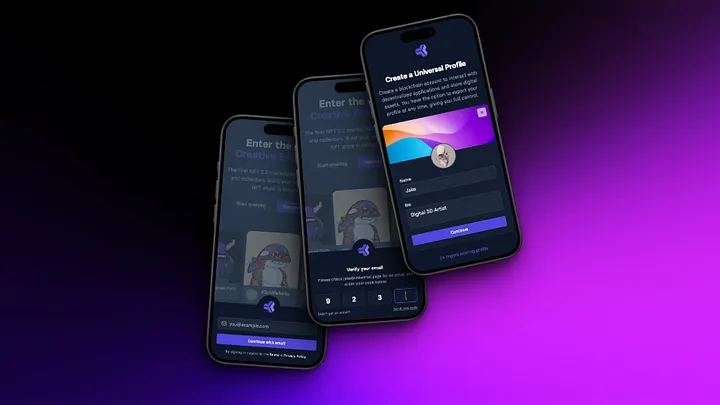Simplifying Web3 for Mass Adoption
Blockchain apps are different from web2 apps in many ways. Decentralized networks are not owned or managed by a single authority and and very useful to keep track of who owns what. This adds a new dimension to the web: digital ownership.
Digital ownership is the crucial concept that makes NFTs and blockchain-based accounts so valuable. It allows digital items and identities to be shared across multiple platforms and gives the users more control. However, people who are new to the world of Web3 face many challenges when they try to get started. This stops the adoption of this new technology. Even though many people own crypto through exchanges, only a tiny number of people are active blockchain users and make regular transactions with their own custodial wallets.
If we want to use crypto for more than just buying and selling, we must improve the technology’s basic building blocks so they can be used for creating complex and exciting consumer applications. We can make changes, like pushing the adoption of smart contract-based accounts (like Universal Profiles) instead of key-based wallets (like MetaMask). Still, before we do that, we need to focus on two essential principles necessary for the more widespread adoption of Web3.
User Experience
It might speak for itself at this point, but the first and most important key to growing blockchain adoption is user experience. Unfortunately, for new users, the process of making transactions is still quite complicated and intimidating. To make a simple transaction, users have to go through many steps. They need to buy tokens to cover the transaction fees (gas), go through KYC, send the tokens to their wallet, and hope everything goes well.
Creating a wallet is also a requirement, which needs to be done through a browser extension or mobile app. The risk of losing a private key can also be a nightmare. Even after completing all the technical requirements, the wallet itself is pretty basic and lacks features and extensibility. It’s not much more than a public and private key, but somehow, everything in Web3 is built around this, even the non-financial apps. The use of key-based wallets is indirectly hindering mainstream adoption.
To make blockchain technology more accessible to the masses, we need to simplify the process and make it more user-friendly. For real adoption to happen, users should be able to create their profile (profiles > wallets) that serves as their Web3 identity. This profile should allow them to move from dapp to dapp and serve as their wallet where they can hold their tokens and NFTs. They should also be able to make a transaction, such as minting a free NFT, in under a minute, preferably with user-friendly options like using their email or mobile phone to sign up and get started. Only then can we start thinking about onboarding the masses. It’s not a nice-to-have; it’s a requirement.
 Use email to create a onchain profile on universal.page
Use email to create a onchain profile on universal.page
Education
To achieve the first principle of web3 onboarding, we must move the technology to the background to make the user experience more comparable with web2 apps. However, people still need to learn about digital ownership and the new concepts that blockchain apps enable.
Blockchains are backend technology, and just like web2, they could be completely hidden from the user. This may make sense, as users also don’t care whether Netflix or Discord is built on top of AWS, Google Cloud, or its own servers. However, this is different. While it’s important for a great user experience, users still need to learn about the new concepts of digital ownership. When someone buys a digital collectible, it is essential to know the blockchain where it is stored. It’s also important to know if a blockchain is even involved in the first place. The ownership of a digital item depends on whether it is stored in an open, decentralized system or a closed, centralized one. If the latter is the case, users may be unable to use the item outside the system.
A friend of mine once bought a digital collectible that he assumed was an NFT, but it turned out it was not. Although the label “digital collectible” might sound more user-friendly, and many people in the NFT space like to use this word more often, you still want to know if it’s an NFT. You need to know if it’s stored on a public blockchain because that’s what enables true digital ownership.
The same goes for your user account. Are you creating an account with a centralized platform or a blockchain account or wallet that you can fully control and take with you? Are you renting your account, and can it be taken from you at any time, or can you use an onchain profile that you fully control and can take with you to other platforms?
New users shouldn’t get overwhelmed with technical terms and new concepts. Still, after a seamless onboarding experience, education is just as important. There is a difference between storing something on a centralized service and on a blockchain. It defines digital ownership, a new dimension on the web that many have yet to experience and learn about.
Conclusion
For blockchain applications to be widely adopted, the user experience must improve, and new users must be educated about new concepts in a seamless way. To achieve the full potential of Web3, we need to simplify the onboarding process and make it as seamless as any Web2 application. Additionally, we need to explain blockchain technology in a way everyone can understand, emphasizing the real-life benefits of digital ownership. By focusing on these key areas, we can create a decentralized web that is inclusive and accessible to all. As builders of blockchain applications, it’s our shared responsibility to guide, educate, and empower users in this transition to a more open, equitable, and interconnected online world.
